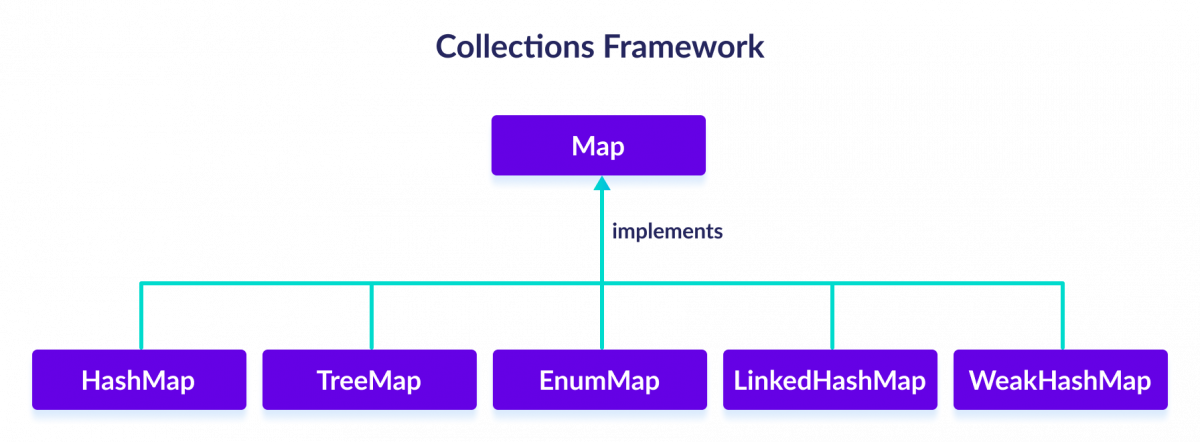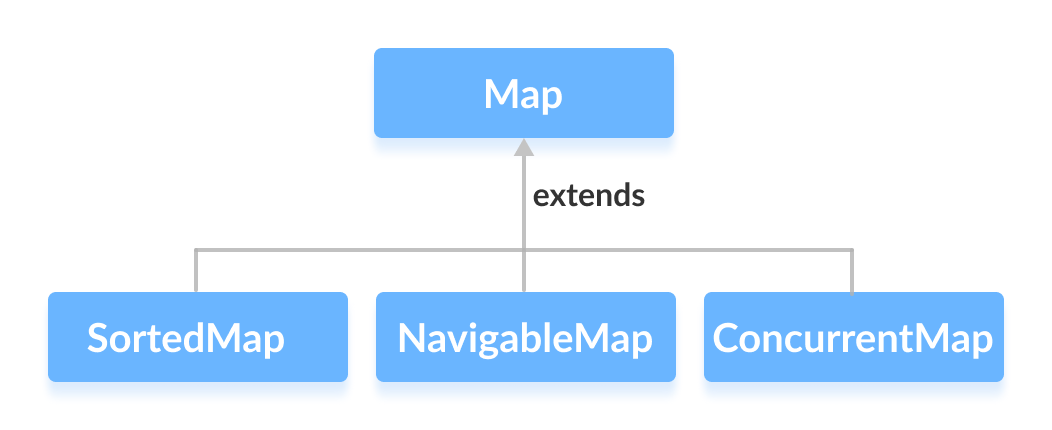The Map interface of the Java collections framework provides the functionality of the map data structure.
Working of Map
In Java, elements of Map are stored in key/value pairs. Keys are unique values associated with individual Values.
A map cannot contain duplicate keys. And, each key is associated with a single value.

We can access and modify values using the keys associated with them.
In the above diagram, we have values: United States, Brazil, and Spain. And we have corresponding keys: us, br, and es.
Now, we can access those values using their corresponding keys.
Note: The Map interface maintains 3 different sets:
- the set of keys
- the set of values
- the set of key/value associations (mapping).
Hence we can access keys, values, and associations individually.
Classes that implement Map
Since Map is an interface, we cannot create objects from it.
In order to use the functionalities of the Map interface, we can use these classes:
These classes are defined in the collections framework and implemented in the Map interface.

Interfaces that extend Map
The Map interface is also extended by these subinterfaces:

How to use Map?
In Java, we must import the java.util.Map package in order to use Map. Once we import the package, here's how we can create a map.
// Map implementation using HashMap
Map<Key, Value> numbers = new HashMap<>();
In the above code, we have created a Map named numbers. We have used the HashMap class to implement the Map interface.
Here,
- Key - a unique identifier used to associate each element (value) in a map
- Value - elements associated by keys in a map
Methods of Map
The Map interface includes all the methods of the Collection interface. It is because Collection is a super interface of Map.
Besides methods available in the Collection interface, the Map interface also includes the following methods:
put(K, V)- Inserts the association of a key K and a value V into the map. If the key is already present, the new value replaces the old value.putAll()- Inserts all the entries from the specified map to this map.putIfAbsent(K, V)- Inserts the association if the key K is not already associated with the value V.get(K)- Returns the value associated with the specified key K. If the key is not found, it returnsnull.getOrDefault(K, defaultValue)- Returns the value associated with the specified key K. If the key is not found, it returns the defaultValue.containsKey(K)- Checks if the specified key K is present in the map or not.containsValue(V)- Checks if the specified value V is present in the map or not.replace(K, V)- Replace the value of the key K with the new specified value V.replace(K, oldValue, newValue)- Replaces the value of the key K with the new value newValue only if the key K is associated with the value oldValue.remove(K)- Removes the entry from the map represented by the key K.remove(K, V)- Removes the entry from the map that has key K associated with value V.keySet()- Returns a set of all the keys present in a map.values()- Returns a set of all the values present in a map.entrySet()- Returns a set of all the key/value mapping present in a map.
Implementation of the Map Interface
1. Implementing HashMap Class
import java.util.Map;
import java.util.HashMap;
class Main {
public static void main(String[] args) {
// Creating a map using the HashMap
Map<String, Integer> numbers = new HashMap<>();
// Insert elements to the map
numbers.put("One", 1);
numbers.put("Two", 2);
System.out.println("Map: " + numbers);
// Access keys of the map
System.out.println("Keys: " + numbers.keySet());
// Access values of the map
System.out.println("Values: " + numbers.values());
// Access entries of the map
System.out.println("Entries: " + numbers.entrySet());
// Remove Elements from the map
int value = numbers.remove("Two");
System.out.println("Removed Value: " + value);
}
}
Output
Map: {One=1, Two=2}
Keys: [One, Two]
Values: [1, 2]
Entries: [One=1, Two=2]
Removed Value: 2
To learn more about HashMap, visit Java HashMap.
2. Implementing TreeMap Class
import java.util.Map;
import java.util.TreeMap;
class Main {
public static void main(String[] args) {
// Creating Map using TreeMap
Map<String, Integer> values = new TreeMap<>();
// Insert elements to map
values.put("Second", 2);
values.put("First", 1);
System.out.println("Map using TreeMap: " + values);
// Replacing the values
values.replace("First", 11);
values.replace("Second", 22);
System.out.println("New Map: " + values);
// Remove elements from the map
int removedValue = values.remove("First");
System.out.println("Removed Value: " + removedValue);
}
}
Output
Map using TreeMap: {First=1, Second=2}
New Map: {First=11, Second=22}
Removed Value: 11
